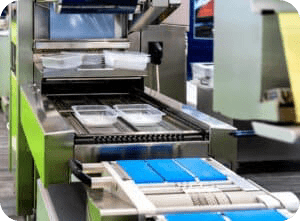Even a few minutes of downtime can derail your entire production schedule—and the wrong equipment choice can magnify that risk. Whether it’s frequent changeovers, limited packaging flexibility, or safety compliance challenges, your packaging line is only as strong as the system behind it. That’s why many plant managers and CEOs find themselves asking the same question: thermoformer vs tray sealer—which is right for us?
This guide breaks it down clearly. You’ll learn how each system works, compare costs and throughput, explore hygiene and sustainability tradeoffs, and discover which machine best fits your product mix, space constraints, and growth strategy. We’ll also walk through real-world examples, ROI models, and maintenance insights—plus how Velec’s MyVelec digital platform gives you an edge in uptime and support.
If you’re planning to invest in new packaging equipment—or just tired of underperforming machines—this is the decision-making guide you’ve been waiting for.
The Basics—How Each System Works
Thermoformers: Form, Fill, Seal Powerhouses
A thermoformer is a roll-fed packaging machine that forms custom-shaped trays from flat plastic film, fills those cavities with product, and then seals the package in-line. These systems shine in high-volume environments. Their output is consistent and fast—often reaching up to 120 packs per minute.
“Thermoformers form their own trays on demand—giving you maximum control over pack shape, material use, and visual presentation.”
They also support advanced packaging types like MAP and VSP, improving shelf life and enhancing food safety and presentation.
Tray Sealers: Versatility in Pre-Formed Trays
Tray sealers work with pre-formed rigid or semi-rigid trays. Products are placed into the trays—manually or via automation—and then sealed with film. This format is popular in ready-meal packaging, fresh produce, and multi-compartment formats.
Quick Takeaway: Tray sealers are ideal for producers who manage many product types and need to switch formats frequently, while thermoformers suit high-speed, high-volume lines that prioritize material control and sealing precision.
Velec’s Perspective
At Velec, we help customers configure both systems based on line layout, volume expectations, and changeover demands. Our solutions pair seamlessly with upstream and downstream equipment to create a fully optimized packaging line.
Key Packaging Applications by Industry
When choosing between a thermoformer and a tray sealer, one of the most important considerations is your industry and product profile. Each system excels in different production environments, and the better matched your equipment is to your output, the greater your operational and financial return.
Where Thermoformers Thrive
Thermoformers are most effective in high-volume, low-variation operations—where the product format stays consistent and output speed is a top priority. Their in-line forming and sealing process makes them ideal for facilities producing:
- Sliced deli meats
- Processed cheese blocks or slices
- Smoked or cured seafood
- Vacuum-packed sausages or hot dogs
- High-speed MAP protein packs
Because thermoformers can produce custom-shaped cavities and maintain precise sealing integrity, they’re particularly effective in applications that use vacuum skin packaging (VSP) or modified atmosphere packaging (MAP) to extend shelf life and improve product presentation.
Where Tray Sealers Excel
Tray sealers offer maximum format flexibility, making them perfect for industries with more frequent changeovers or diverse packaging formats. These systems are ideal for:
- Ready meals with multiple compartments
- Pre-cut produce or salad kits
- Yogurt cups, dips, and small dairy packs
- Specialty co-packing and private label formats
- Plant-based protein trays and promotional formats
Tray sealers allow for fast, tool-free changeovers and accommodate a wide range of tray materials, including paperboard, rPET, and compostable trays. That makes them a go-to choice for brands looking to emphasize sustainability or differentiate visually on retail shelves.
At Velec, we frequently support tray sealing lines with precision loading systems for sausages, patties, or fruit segments—reducing labor and boosting line efficiency without changing sealing hardware.
Performance Comparison: Speed, Footprint, Flexibility
When evaluating thermoformers vs tray sealers, performance often comes down to three practical concerns: how fast they run, how much space they require, and how easily they adapt to different products or formats. The right fit depends not only on machine specs, but also on how your team works—and how often your line changes.
Speed: Thermoformers Win the Race
Thermoformers are built for speed. High-end models regularly hit 80–120 packs per minute, especially when running uniform products like sausages, sliced meats, or cheese blocks. Because the forming, filling, and sealing steps are automated in-line, thermoformers eliminate many of the slowdowns caused by manual loading or tray changes.
They’re particularly advantageous for long runs of the same product where every second counts.
Tray sealers, on the other hand, typically top out around 40–80 packs per minute, depending on tray type, seal area, and upstream loading efficiency. But what they lack in raw speed, they make up for in flexibility—more on that below.
“Thermoformers outperform in speed and output consistency—especially when paired with upstream automation like Velec’s sausage loader.”
Footprint: Tray Sealers Fit Where Others Can’t
When it comes to layout and real estate, tray sealers are the clear winners. A compact inline tray sealer can occupy 20–30% less space than a thermoformer with comparable output.
Thermoformers require additional floor space for:
- Film unwind and heating systems
- Vacuum or gas flushing chambers
- Extended conveyors and cutting tools
- Utilities like compressed air and cooling loops
If your facility is tight on space, a tray sealer with modular feeders and loaders (like Velec’s inline orientation systems) may offer better efficiency without a full redesign.
Flexibility: Tray Sealers Adapt, Thermoformers Dominate Uniformity
Tray sealers excel in multi-SKU environments. Changeovers can be completed in minutes, and tooling costs are lower. They’re ideal if you need to swap tray shapes, sizes, or sealing films frequently—like seasonal ready meals or private label co-packing.
Thermoformers are more rigid. Each new format often requires dedicated tooling, downtime, and material testing. But if your line runs the same format day after day, that “inflexibility” becomes an asset—boosting reliability and speed.
Flexibility Test
- Run 5+ SKUs per shift? → Tray Sealer
- Same SKU for 2+ shifts? → Thermoformer
Downtime and Changeovers
Unplanned downtime and inefficient changeovers are the silent killers of packaging line productivity. In an environment where every minute equals lost revenue, the ease and speed of resetting between runs can heavily sway your choice between a thermoformer vs tray sealer.
Tray Sealers: The Changeover Champs
If you’re running multiple SKUs daily, tray sealers have the upper hand. They allow for:
- Tool-free tray size changes
- Minimal warm-up or cooling time
- Quick adjustments to film rolls and seal heads
In some systems, full changeovers can be done in under 10 minutes, especially when paired with Velec’s smart loading systems that auto-adjust to new formats.
This makes tray sealers ideal for co-packers, private label producers, and meal kit companies, where product variety is high and downtime tolerance is low.
Thermoformers: Fast Once You’re Locked In
Thermoformers, on the other hand, require more extensive tooling swaps between formats. A changeover can involve:
- Swapping forming dies
- Recalibrating seal temperatures and dwell times
- Adjusting conveyor and loading systems
This can take 30–90 minutes, depending on operator experience and system complexity. However, for long runs of the same product, thermoformers outperform in uptime. Once dialed in, they run longer without adjustments.
Velec’s Perspective
Most downtime isn’t caused by the thermoformer or tray sealer—it’s what happens before and after. Velec helps reduce changeover time with:
- Automated loading and orientation systems
- Quick-release and recipe-based configuration
- MyVelec’s real-time diagnostics and part tracking
“It’s not just the sealing machine—it’s the 10 minutes before and after it that add up. That’s where Velec saves time.”
Hygiene and Cleanability
In food processing, hygienic design isn’t optional—it’s regulated. How easy it is to clean your packaging equipment affects your compliance, your labor hours, and your risk of a costly recall.
Thermoformers: Integrated But Complex
Thermoformers are largely enclosed and perform forming, filling, and sealing in a single line. While that limits contamination risk from handling, it also means:
- Harder-to-access interior components
- More surfaces requiring disassembly
- Specialized cleaning tools or procedures
Their high-speed and integrated nature makes deep cleaning more time-consuming, especially during allergen changeovers.
Tray Sealers: Open Access, Easier Sanitation
Tray sealers generally have fewer enclosed spaces and more open, accessible components. This makes them:
- Faster to clean
- Easier to inspect for residues
- Less complex for sanitation teams to train on
When used in wet environments or facilities running allergens, this easier access becomes a major operational advantage.
Sustainability and Packaging Material Use
For many food brands, packaging isn’t just a container—it’s a statement. With consumer pressure and regulations on the rise, choosing equipment that supports your sustainability goals is now part of the ROI discussion.
Tray Sealers: Material Diversity and Green Options
Tray sealers work with a broad range of eco-friendly materials, including:
- Recycled PET (rPET) trays
- Paperboard or fiber-based trays
- Compostable biopolymers
This flexibility allows producers to meet retailer mandates (like Tesco’s or Aldi’s tray policies) and reduce carbon footprints without major equipment changes.
Plus, if you’re moving toward recyclable mono-material films, tray sealers typically require less heat and pressure—making them easier to adapt.
Thermoformers: Less Material Waste, But Less Flexibility
Thermoformers generate less packaging waste by weight, as the film is thin and formed on-demand. However, they are usually limited to:
- Multilayer barrier films
- Plastic-based forming webs
- Less adaptability to rigid compostable trays
That said, some high-efficiency thermoforming lines now integrate scrap film rewind systems to reduce landfill waste.
Quick Takeaways
- Thermoformers reduce unit costs and maximize speed for high-volume lines.
- Tray sealers excel at flexibility and faster changeovers, ideal for SKU-heavy operations.
- Both systems support MAP and VSP packaging, but thermoformers offer tighter control.
- Tray sealers integrate easily with sustainable materials.
- Velec’s MyVelec platform boosts uptime and maintenance efficiency.
Conclusion: Align Your Packaging Strategy with Growth
Choosing between a thermoformer and a tray sealer isn’t just a technical decision—it’s a strategic investment. Both machines offer clear advantages, but the right system depends on your product mix, output goals, and changeover demands.
Velec provides more than equipment—we deliver end-to-end packaging solutions backed by real-time diagnostics, expert support, and systems that evolve with your operation.
CTA Block: Book a Free Line Audit with Velec Discover which machine best fits your goals—and what it will take to reduce downtime, improve yield, and future-proof your packaging.
❓ FAQs
What’s the difference between a thermoformer and a tray sealer? Thermoformers form trays in-line from film; tray sealers use pre-formed trays. Each has unique advantages depending on your production needs.
Which is better for small batches or co-packing? Tray sealers. They offer faster changeovers and are ideal for operations with multiple formats or lower volume.
Do both systems support MAP or vacuum skin packaging? Yes. Thermoformers offer more control, but both can handle MAP and VSP with the right configuration.
What is the average speed difference? Thermoformers: 80–120 packs/min. Tray sealers: 40–80 packs/min.
Which is more sustainable? Tray sealers are often used with recyclable or compostable trays. Thermoformers create less waste by weight but use plastic-based films.
📋 References
ProvisionerOnline, “Comparing Pre-Made vs Thermoformed Trays,” 2018
AMAC Technologies, “Automatic Tray Sealing vs Thermoforming Machines,” 2023
Packaging Automation Ltd, “Tray Sealing vs Thermoform,” 2021
Flexible Packaging Insider, “Thermoforming Trends in North America,” 2024







